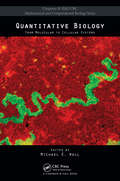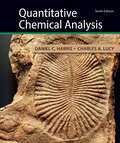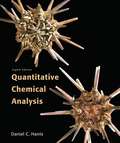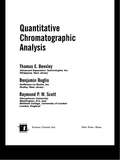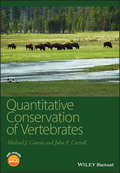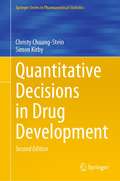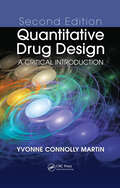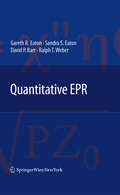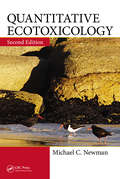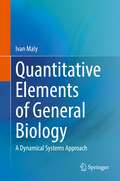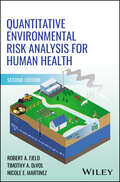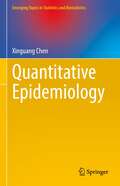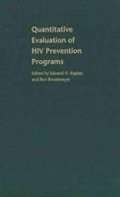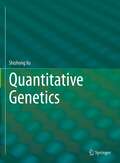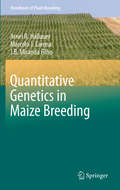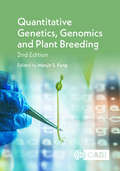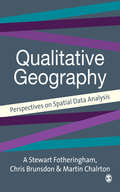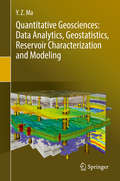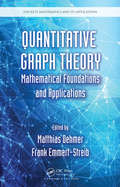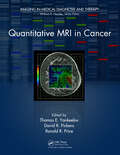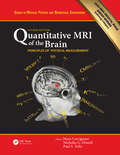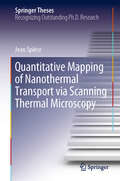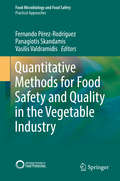- Table View
- List View
Quantitative Biology: From Molecular to Cellular Systems (Chapman & Hall/CRC Mathematical Biology Series)
by Michael E. WallQuantitative methods are revolutionizing modern molecular and cellular biology. Groundbreaking technical advances are fueling the rapid expansion in our ability to observe, as seen in multidisciplinary studies that integrate theory, computation, experimental assays, and the control of microenvironments. Integrating new experimental and theoretical
Quantitative Chemical Analysis
by Daniel C. Harris Charles A. LucyThe gold standard in analytical chemistry, Dan Harris' Quantitative Chemical Analysis provides a sound physical understanding of the principles of analytical chemistry and their applications in the disciplines.
Quantitative Chemical Analysis
by Daniel Harris Charles LucyThe 10th edition of Quantitative Chemical Analysis continues to set the standard for learning analytical chemistry with distinguished writing, the most up-to-date content, and now the acclaimed SaplingPlus program, supporting exceptional problem solving practice. New author Charles Lucy joins Dan Harris, infusing additional subject expertise and classroom experience into the 10th edition.SaplingPlus combines Sapling’s renowned online homework with an extensive suite of engaging multimedia learning resources and a full eBook of Quantitative Chemical Analysis, 10e.
Quantitative Chemical Analysis
by Daniel C. HarrisThe most widely used analytical chemistry textbook in the world, Dan Harris's Quantitative Chemical Analysis provides a sound physical understanding of the principles of analytical chemistry, showing how these principles are applied in chemistry and related disciplines--especially in life sciences and environmental science As always, the new edition incorporates real data, spreadsheets, and a wealth of applications, in a witty, personable presentation that engages students without compromising the depth necessary for a thorough and practical understanding of analytical chemistry.
Quantitative Chromatographic Analysis
by Thomas Beesley Benjamin BuglioHighlights critical factors involved in successful chromatographic analysis. Details analytical procedures; outlining sample preparation, collection, transportation, and storage. Provides step-by-step guidelines for producing analytical reports.
Quantitative Conservation of Vertebrates: Spanish Language Edition
by Michael J. Conroy John P. CarrollThis book provides a hands-on introduction to the construction and application of models to studies of vertebrate distribution, abundance, and habitat. The book is aimed at field biologists, conservation planners, and advanced undergraduate and postgraduate students who are involved with planning and analyzing conservation studies, and applying the results to conservation decisions. The book also acts as a bridge to more advanced and mathematically challenging coverage in the wider literature. Part I provides a basic background in population and community modeling. It introduces statistical models, and familiarizes the reader with important concepts in the design of monitoring and research programs. These programs provide the essential data that guide conservation decision making. Part II covers the principal methods used to estimate abundance, occupancy, demographic parameters, and community parameters, including occupancy sampling, sample counts, distance sampling, and capture-mark-recapture (for both closed and open populations). Emphasis is placed on practical aspects of designing and implementing field studies, and the proper analysis of data. Part III introduces structured decision making and adaptive management, in which predictive models are used to inform conservation decision makers on appropriate decisions in the face of uncertainty—with the goal of reducing uncertainty through monitoring and research. A detailed case study is used to illustrate each of these themes. Numerous worked examples and accompanying electronic material (on a website - http://www.blackwellpublishing.com/conroy - and accompanying CD) provide the details of model construction and application, and data analysis.
Quantitative Decisions in Drug Development (Springer Series in Pharmaceutical Statistics)
by Christy Chuang-Stein Simon KirbyThis book focuses on important decision points and evidence needed for making decisions at these points during the development of a new drug. It takes a holistic approach towards drug development by incorporating explicitly knowledge learned from the earlier part of the development and available historical information into decisions at later stages. In addition, the book shares lessons learned from several select examples published in the literature since the publication of the first edition. The second edition reiterates the need for making evidence-based Go/No Go decisions in drug development discussed in the first edition. It substantially expands several topics that have seen great advances since the publication of the first edition. The most noticeable additions include three adaptive trials conducted in recent years that offer excellent learning opportunities, the use of historical data in the design and analysis of clinical trials, and extending decision criteria to the cases when the primary endpoint is binary. The examples used to illustrate the additional materials all come from real trials with some post-trial reflections offered by the authors. The book begins with an overview of product development and regulatory approval pathways. It then discusses how to incorporate prior knowledge into study design and decision making at different stages of drug development. Prior knowledge includes information pertaining to historical controls. To assist decision making, the book discusses appropriate metrics and the formulation of go/no-go decisions for progressing a drug candidate to the next development stage. Using the concept of the positive predictive value in the field of diagnostics, the book leads readers to the assessment of the probability that an investigational product is effective given positive study outcomes. Lastly, the book points out common mistakes made by drug developers under the current drug-development paradigm. The book offers useful insights to statisticians, clinicians, regulatory affairs managers and decision-makers in the pharmaceutical industry who have a basic understanding of the drug-development process and the clinical trials conducted to support drug-marketing authorization. The authors provide software codes for select analytical approaches discussed in the book. The book includes enough technical details to allow statisticians to replicate the quantitative illustrations so that they can generate information to facilitate decision-making themselves.
Quantitative Drug Design: A Critical Introduction, Second Edition
by Yvonne C. MartinSince the publication of the first edition, the field has changed dramatically. Scientists can now explicitly consider 3D features in quantitative structure-activity relationship (QSAR) studies and often have the 3D structure of the macromolecular target to guide the 3D QSAR. Improvements in computer hardware and software have also made the methods
Quantitative EPR
by Gareth R. Eaton David P. Barr Sandra S. Eaton Ralph T. WeberThis is the first comprehensive practical guide for people who perform EPR measurements, or supervise the use of EPR spectroscopy, and want to obtain quantitative results. No existing book provides this level of practical guidance to ensure successful use of EPR. This meets the growing need in both industrial and academic research to provide meaningful and accurate quantitative results from EPR experiments. Discussed are the various sample-related, instrument-related and software-related aspects for obtaining useful quantitative results from EPR experiments. Some specific items discussed include: choosing a reference standard, resonator considerations (Q, B1, Bm), power saturation characteristics, sample positioning, and finally, putting all the factors together to provide a calculation model for obtaining an accurate spin concentration of a sample. Both relative intensity quantification and the absolute spin concentration of EPR samples are covered as well. Numerous pictures of the effect of instrument parameters on EPR spectra are included and careful attention to the guidance given in this book will ensure quantitatively accurate EPR spectra.
Quantitative Ecotoxicology
by Michael C. NewmanQuantitative Ecotoxicology, Second Edition explores models and methods of quantitative ecotoxicology at progressively higher biological scales using worked examples and common software packages. It complements the author's previous books, Fundamentals of Ecotoxicology, Third Edition and Ecotoxicology: A Comprehensive Treatment. Encouraging a more r
Quantitative Elements of General Biology: A Dynamical Systems Approach
by Ivan MalyThis monograph sketches out a broad spectrum of problems (from evolution and metabolism to morphogenesis and biogeographical dynamics) whose solution has been impacted by mathematical models. Each of the selected examples has led to the recognition—and set direction to further study—of certain fundamental but unintuitive properties of biological systems, such as the making and breaking of specific symmetries that underlie morphogenesis. Whether they are long-established or only recently accepted, these models are selected for being thought-provoking and illuminating both the achievements and the gaps in our current understanding of the given area of biology. The selection of models is also meant to bring to the fore the existing degree of unity in the quantitative approach to diverse general-biological questions and in the systems-level properties that are discovered across the levels of biological organization. It is the thesis of this book that further cultivation of such unity is a way forward as we progress toward a general theory of living matter.This is an ideal book for students (in the broadest sense) of biology who wish to learn from this attempt to present the exemplary models, their methodological lessons, and the outline of a unified theory of living matter that is now beginning to emerge. In addition to a doctoral student preparing for quantitative biology research, this reader could also be an interdisciplinary scientist transitioning to biology. The latter—for example, a physicist or an engineer—may be comfortable with the mathematical apparatus and prepared to quickly enter the intended area of work, but desires a broader foundation in biology from the quantitative perspective.
Quantitative Environmental Risk Analysis for Human Health
by Robert A. Fjeld Timothy A. DeVol Nicole E. MartinezQUANTITATIVE ENVIRONMENTAL RISK ANALYSIS FOR HUMAN HEALTH An updated edition of the foundational guide to environmental risk analysis Environmental risk analysis is a systematic process essential for the evaluation, management, and communication of the human health risk posed by the release of contaminants to the environment. Performed correctly, risk analysis is an essential tool in the protection of the public from the health hazards posed by chemical and radioactive contaminants. Cultivating the quantitative skills required to perform risk analysis competently is a critical need. Quantitative Environmental Risk Analysis for Human Health meets this need with a thorough, comprehensive coverage of the fundamental knowledge necessary to assess environmental impacts on human health. It introduces readers to a robust methodology for analyzing environmental risk, as well as to the fundamental principles of uncertainty analysis and the pertinent environmental regulations. Now updated to reflect the latest research and new cutting-edge methodologies, this is an essential contribution to the practice of environmental risk analysis. Readers of the second edition of Quantitative Environmental Risk Analysis for Human Health will also find: Detailed treatment of source and release characterization, contaminant migration, exposure assessment, and more New coverage of computer-based analytical methods A new chapter of case studies providing actual, real-world examples of environmental risk assessments Quantitative Environmental Risk Analysis for Human Health is must-have for graduate and advanced undergraduate students in civil engineering, environmental engineering, and environmental science, as well as for risk analysis practitioners in industry, environmental consultants, and regulators.
Quantitative Epidemiology (Emerging Topics in Statistics and Biostatistics)
by Xinguang ChenThis book is designed to train graduate students across disciplines within the fields of public health and medicine, with the goal of guiding them in the transition to independent researchers. It focuses on theories, principles, techniques, and methods essential for data processing and quantitative analysis to address medical, health, and behavioral challenges. Students will learn to access to existing data and process their own data, quantify the distribution of a medical or health problem to inform decision making; to identify influential factors of a disease/behavioral problem; and to support health promotion and disease prevention. Concepts, principles, methods and skills are demonstrated with SAS programs, figures and tables generated from real, publicly available data. In addition to various methods for introductory analysis, the following are featured, including 4-dimensional measurement of distribution and geographic mapping, multiple linear and logistic regression, Poisson regression, Cox regression, missing data imputing, and statistical power analysis.
Quantitative Evaluation of HIV Prevention Programs
by Edward H. Kaplan Ron BrookmeyerThis book shows the quantitative evaluation of HIV issues.
Quantitative Fundamentals of Molecular and Cellular Bioengineering
by K. Dane Wittrup Bruce Tidor Benjamin J. Hackel Casim A. SarkarA comprehensive presentation of essential topics for biological engineers, focusing on the development and application of dynamic models of biomolecular and cellular phenomena.This book describes the fundamental molecular and cellular events responsible for biological function, develops models to study biomolecular and cellular phenomena, and shows, with examples, how models are applied in the design and interpretation of experiments on biological systems. Integrating molecular cell biology with quantitative engineering analysis and design, it is the first textbook to offer a comprehensive presentation of these essential topics for chemical and biological engineering.The book systematically develops the concepts necessary to understand and study complex biological phenomena, moving from the simplest elements at the smallest scale and progressively adding complexity at the cellular organizational level, focusing on experimental testing of mechanistic hypotheses. After introducing the motivations for formulation of mathematical rate process models in biology, the text goes on to cover such topics as noncovalent binding interactions; quantitative descriptions of the transient, steady state, and equilibrium interactions of proteins and their ligands; enzyme kinetics; gene expression and protein trafficking; network dynamics; quantitative descriptions of growth dynamics; coupled transport and reaction; and discrete stochastic processes. The textbook is intended for advanced undergraduate and graduate courses in chemical engineering and bioengineering, and has been developed by the authors for classes they teach at MIT and the University of Minnesota.
Quantitative Genetics
by Shizhong XuThe intended audience of this textbook are plant and animal breeders, upper-level undergraduate and graduate students in biological and agricultural science majors. Statisticians who are interested in understanding how statistical methods are applied to genetics and agriculture can benefit substantially by reading this book. One characteristic of this textbook is represented by three chapters of technical reviews for Mendelian genetics, population genetics and preliminary statistics, which are prerequisites for studying quantitative genetics. Numerous examples are provided to illustrate different methods of data analysis and estimation of genetic parameters. Along with each example of data analyses is the program code of SAS (statistical analysis system).
Quantitative Genetics in Maize Breeding
by Marcelo J. Carena Arnel R. Hallauer J.B. Miranda FilhoMaize is used in an endless list of products that are directly or indirectly related to human nutrition and food security. Maize is grown in producer farms, farmers depend on genetically improved cultivars, and maize breeders develop improved maize cultivars for farmers. Nikolai I. Vavilov defined plant breeding as plant evolution directed by man. Among crops, maize is one of the most successful examples for breeder-directed evolution. Maize is a cross-pollinated species with unique and separate male and female organs allowing techniques from both self and cross-pollinated crops to be utilized. As a consequence, a diverse set of breeding methods can be utilized for the development of various maize cultivar types for all economic conditions (e.g., improved populations, inbred lines, and their hybrids for different types of markets). Maize breeding is the science of maize cultivar development. Public investment in maize breeding from 1865 to 1996 was $3 billion (Crosbie et al., 2004) and the return on investment was $260 billion as a consequence of applied maize breeding, even without full understanding of the genetic basis of heterosis. The principles of quantitative genetics have been successfully applied by maize breeders worldwide to adapt and improve germplasm sources of cultivars for very simple traits (e.g. maize flowering) and very complex ones (e.g., grain yield). For instance, genomic efforts have isolated early-maturing genes and QTL for potential MAS but very simple and low cost phenotypic efforts have caused significant and fast genetic progress across genotypes moving elite tropical and late temperate maize northward with minimal investment. Quantitative genetics has allowed the integration of pre-breeding with cultivar development by characterizing populations genetically, adapting them to places never thought of (e.g., tropical to short-seasons), improving them by all sorts of intra- and inter-population recurrent selection methods, extracting lines with more probability of success, and exploiting inbreeding and heterosis. Quantitative genetics in maize breeding has improved the odds of developing outstanding maize cultivars from genetically broad based improved populations such as B73. The inbred-hybrid concept in maize was a public sector invention 100 years ago and it is still considered one of the greatest achievements in plant breeding. Maize hybrids grown by farmers today are still produced following this methodology and there is still no limit to genetic improvement when most genes are targeted in the breeding process. Heterotic effects are unique for each hybrid and exotic genetic materials (e.g., tropical, early maturing) carry useful alleles for complex traits not present in the B73 genome just sequenced while increasing the genetic diversity of U.S. hybrids. Breeding programs based on classical quantitative genetics and selection methods will be the basis for proving theoretical approaches on breeding plans based on molecular markers. Mating designs still offer large sample sizes when compared to QTL approaches and there is still a need to successful integration of these methods. There is a need to increase the genetic diversity of maize hybrids available in the market (e.g., there is a need to increase the number of early maturing testers in the northern U.S.). Public programs can still develop new and genetically diverse products not available in industry. However, public U.S. maize breeding programs have either been discontinued or are eroding because of decreasing state and federal funding toward basic science. Future significant genetic gains in maize are dependent on the incorporation of useful and unique genetic diversity not available in industry (e.g., NDSU EarlyGEM lines). The integration of pre-breeding methods with cultivar development should enhance future breeding efforts to maintain active public breeding programs not only adapting and improving genetically broad-based germplasm but also developing unique products and training the next generation of maize breeders producing ...
Quantitative Genetics, Genomics and Plant Breeding
by Weikai Yan Salvatore Ceccarelli Surinder S Banga Nourollah Ahmadi Jacqueline Batley Baffour Badu-Apraku José Crossa Ravi Prakash Singh Manjit Kang Meike S Anderson Robyn Anderson Paolo Annicchiarico Vivi N Arief Jérôme Bartholomé Kaye E Basford Dharminder Bhatia Darshan S Brar Juan Burgueño Tuong-Vi Cao Hernán Ceballos Sandeep Chapagain Binu Cherian Monica Danilevicz Ian H DeLacy Professor Dave Edwards M A Fakorede Cassie Tay Fernandez Mahalingam Govindaraj Cécile Grenier Mehak Gupta L A Hunt Shailesh Vinay Joshi Philomin Juliana Anand Kanatti M T Labuschagne D Lloyd Evans Suschismita Modal Gurbachan S Miglani Osval A Montesinos-López E Obeng-Bio S A Oyekale Paulino Pérez-Rodríguez Wolfgang H Pfeiffer M Pillay K N Rai Lovepreet Singh Rajveer Singh Prasanta K Subudhi A O Talabi S N Tchala Soodeh Tirnaz Parminder S VirkSince the first edition of this book was published in 2002, the field of quantitative genetics, genomics and breeding has changed markedly. In response, only four chapters have been updated for this new edition, and the remaining 16 chapters are entirely new. This book presents state-of-the-art, authoritative chapters on contemporary issues in the broad areas of quantitative genetics, genomics and plant breeding. Section 1 (Chapters 2 to 12) emphasizes the application of genomics, and genome and epigenome editing techniques, in plant breeding; bioinformatics; quantitative trait loci mapping; and the latest approaches of examining and exploiting genotype-environment interactions. Section 2 (Chapters 13 to 20) represents the intersection of breeding, genetics and genomics. This section describes the use of cutting-edge molecular breeding and quantitative genetics techniques in wheat, rice, maize, root and tuber crops and pearl millet. Overall, the book focuses on using genomic information to help evaluate traits that can combat biotic/abiotic stresses, genome-wide association mapping, high-throughput genotyping/phenotyping, biofortification, use of big data, orphan crops, and gene editing techniques. The examples featured are taken from across crop science research and cover a wide geographical base. This book contains: chapters by expert authors from six continents; state-of-the-art information on topical areas relative to crop improvement; coverage of genome-editing techniques.
Quantitative Geography: Perspectives on Spatial Data Analysis
by Martin Charlton Chris Brunsdon A. Stewart FotheringhamIntegrating a discussion of the application of quantitative methods with practical examples, this book explains the philosophy of the new quantitative methodologies and contrasts them with the methods associated with geography's `Quantitative Revolution' of the 1960s. Key issues discussed include: the nature of modern quantitative geography; spatial data; geographical information systems; visualization; local analysis; point pattern analysis; spatial regression; and statistical inference. Concluding with a review of models used in spatial theory, the authors discuss the current challenges to spatial data analysis. Written to be accessible, to communicate the diversity and excitement of recent thinking, Quantitative Geography will be required reading for students and researchers in any discipline where quantitative methods are used to analyse spatial data. `This is a veritable tour de force of everything that is exciting about quantitative geography and GIS. It is a timely, thorough and exciting account of the state of the art and science of spatial analysis' - Paul Longley, University of Bristol `A highly innovative and up-to-date text. It is unique in its coverage of the many developments that have taken place in the field over the past few years. The book is one that is highly readable and stimulating for those with some background in the field, and its expositional style and many examples will make it stimulating to newcomers as well' - Peter Rogerson, State University of New York at Buffalo `Brings the field thoroughly up to date, integrating modern methods of GIS with a comprehensive and easy-to-read overview of the most recent and powerful techniques of spatial analysis. The book will be valuable to students and researchers in any discipline that seeks to explore or explain phenomena in geographical context, and will make excellent reading for geographers, political scientists, criminologists, anthropologists, geologists, epidemiologists, ecologists, and many others. It offers a spirited challenge to critics of a scientific approach to social science, and demonstrates the value of its subject matter through abundant examples' - Michael Goodchild, National Center for Geographic Information and Analysis, University of California, Santa Barbara `There is a view within some parts of academic geography that what used to be called "quantitative geography" is dead, having been subsumed within "geographical information systems" or else of no continuing interest. This book should correct this view. First, it shows that quantitative methods have remained an exciting area of development and, second, it shows that, if anything, they have more relevance to substantive problems of interest than they have ever had. Although not specifically about GIS, it is a book that should be read by everyone concerned with the analysis of geographical information' - David Unwin, Birkbeck College, University of London
Quantitative Geosciences: Data Analytics, Geostatistics, Reservoir Characterization and Modeling
by Y. Z. MaEarth science is becoming increasingly quantitative in the digital age. Quantification of geoscience and engineering problems underpins many of the applications of big data and artificial intelligence. This book presents quantitative geosciences in three parts. Part 1 presents data analytics using probability, statistical and machine-learning methods. Part 2 covers reservoir characterization using several geoscience disciplines: including geology, geophysics, petrophysics and geostatistics. Part 3 treats reservoir modeling, resource evaluation and uncertainty analysis using integrated geoscience, engineering and geostatistical methods. As the petroleum industry is heading towards operating oil fields digitally, a multidisciplinary skillset is a must for geoscientists who need to use data analytics to resolve inconsistencies in various sources of data, model reservoir properties, evaluate uncertainties, and quantify risk for decision making. This book intends to serve as a bridge for advancing the multidisciplinary integration for digital fields. The goal is to move beyond using quantitative methods individually to an integrated descriptive-quantitative analysis. In big data, everything tells us something, but nothing tells us everything. This book emphasizes the integrated, multidisciplinary solutions for practical problems in resource evaluation and field development.
Quantitative Graph Theory: Mathematical Foundations and Applications
by Matthias Dehmer Frank Emmert-StreibThe first book devoted exclusively to quantitative graph theory, Quantitative Graph Theory: Mathematical Foundations and Applications presents and demonstrates existing and novel methods for analyzing graphs quantitatively. Incorporating interdisciplinary knowledge from graph theory, information theory, measurement theory, and statistical technique
Quantitative MRI in Cancer (Imaging in Medical Diagnosis and Therapy)
by Thomas E. Yankeelov David R. Pickens Ronald R. PricePropelling quantitative MRI techniques from bench to bedside, Quantitative MRI in Cancer presents a range of quantitative MRI methods for assessing tumor biology. It includes biophysical and theoretical explanations of the most relevant MRI techniques as well as examples of these techniques in cancer applications.The introductory part of the book c
Quantitative MRI of the Brain: Principles of Physical Measurement, Second edition (Series in Medical Physics and Biomedical Engineering)
by Mara Cercignani Nicholas G. Dowell Paul S. ToftsBuilding on the success of the first edition of this book, the winner of the 2004 British Medical Association Radiology Medical Book Competition, Quantitative MRI of the Brain: Principles of Physical Measurement gives a unique view on how to use an MRI machine in a new way. Used as a scientific instrument it can make measurements of a myriad of physical and biological quantities in the human brain and body. For each small tissue voxel, non-invasive information monitors how tissue changes with disease and responds to treatment. The book opens with a detailed exposition of the principles of good practice in quantification, including fundamental concepts, quality assurance, MR data collection and analysis and improved study statistical power through minimised instrumental variation. There follow chapters on 14 specific groups of quantities: proton density, T1, T2, T2*, diffusion, advanced diffusion, magnetisation transfer, CEST, 1H and multi-nuclear spectroscopy, DCE-MRI, quantitative fMRI, arterial spin-labelling and image analysis, and finally a chapter on the future of quantification. The physical principles behind each quantity are stated, followed by its biological significance. Practical techniques for measurement are given, along with pitfalls and examples of clinical applications. This second edition of this indispensable 'how to' manual of quantitative MR shows the MRI physicist and research clinician how to implement these techniques on an MRI scanner to understand more about the biological processes in the patient and physiological changes in healthy controls. Although focussed on the brain, most techniques are applicable to characterising tissue in the whole body. This book is essential reading for anyone who wants to use the gamut of modern quantitative MRI methods to measure the effects of disease, its progression, and its response to treatment. Features: The first edition was awarded the book prize for Radiology by the British Medical Association in 2004 Written by an authority in the field: Professor Tofts has an international reputation for quantification in MRI Gives specific ‘how to’ information for implementation of MRI measurement sequence techniques
Quantitative Mapping of Nanothermal Transport via Scanning Thermal Microscopy (Springer Theses)
by Jean SpièceThe thesis tackles one of the most difficult problems of modern nanoscale science and technology - exploring what governs thermal phenomena at the nanoscale, how to measure the temperatures in devices just a few atoms across, and how to manage heat transport on these length scales. Nanoscale heat generated in microprocessor components of only a few tens of nanometres across cannot be effectively fed away, thus stalling the famous Moore's law of increasing computer speed, valid now for more than a decade. In this thesis, Jean Spièce develops a novel comprehensive experimental and analytical framework for high precision measurement of heat flows at the nanoscale using advanced scanning thermal microscopy (SThM) operating in ambient and vacuum environment, and reports the world’s first operation of cryogenic SThM. He applies the methodology described in the thesis to novel carbon-nanotube-based effective heat conductors, uncovers new phenomena of thermal transport in two- dimensional (2D) materials such as graphene and boron nitride, thereby discovering an entirely new paradigm of thermoelectric cooling and energy production using geometrical modification of 2D materials.
Quantitative Methods for Food Safety and Quality in the Vegetable Industry
by Fernando Pérez-Rodríguez Panagiotis Skandamis Vasilis ValdramidisThis book focuses on the food safety challenges in the vegetable industry from primary production to consumption. It describes existing and innovative quantitative methods that could be applied to the vegetable industry for food safety and quality, and suggests ways in which such methods can be applied for risk assessment. Examples of application of food safety objectives and other risk metrics for microbial risk management in the vegetable industry are presented. The work also introduces readers to new preservation and packaging methods, advanced oxidative processes (AOPs) for disinfection, product shelf-life determination methods, and rapid analytic methods for quality assessment based on chemometrics applications, thus providing a quantitative basis for the most important aspects concerning safety and quality in the vegetable sector.
